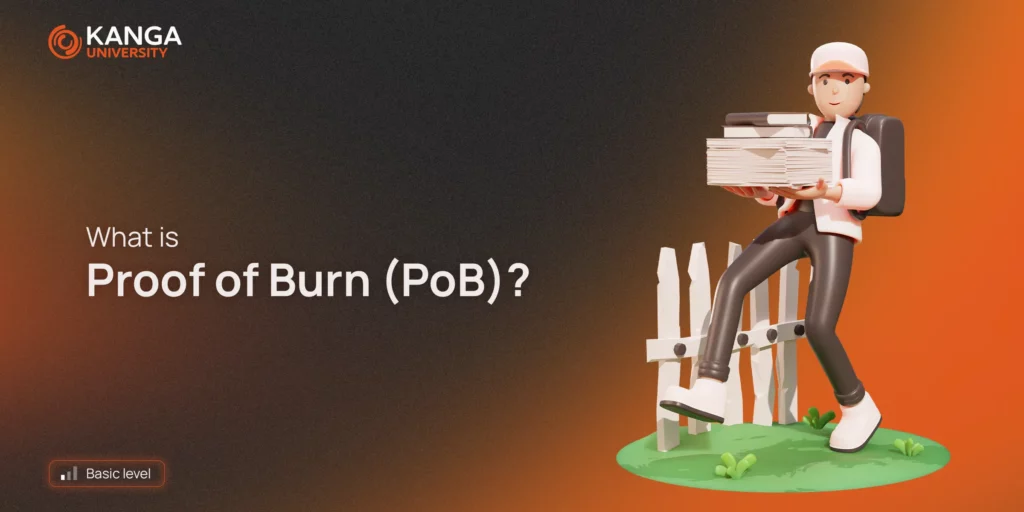

At our academy we have already discussed some consensus mechanisms: Proof of Stake and Proof of Work and Proof of Authority (PoA). Today we have a look at another one of them – Proof of Burn (PoB). Blockchain networks use consensus mechanisms to get users to agree to new updates. Therefore, to ensure continuity in network algorithms, it must first be established.
What is Proof of Burn (PoB)?
As the name suggests, Proof of Burn is proof of burning. Miners, thus, gain consensus by burning coins. Coin burning is a process in which a certain number of coins are permanently eliminated from circulation. In this way, the Proof of Burn is used to validate a given transaction. Therefore, the more coins the miner burns, the higher his chances of adding a block to the network.
Compared to the consensus mechanisms we have been discussing – Proof of Stake, or Proof of Work, the Proof-of-Burn mechanism reduces energy consumption. It also does not require miners to stake coins to add a new block to the network.
In the blockchain network, there are several versions of the Proof of Burn consensus mechanism. The most popular is Iain Stewart’s version. As you have already guessed, he is also its inventor.
The very concept of coin burning also means investing the native tokens of a given ecosystem in virtual mining platforms (mining powers). This allows miners who own multiple mining platforms or invest the most coins to add a new block to the network.
Remember also that the number of coins burned by a miner shows his commitment to the network.
How does the Proof of Burn consensus mechanism work?
Miners, involved in the network, send a certain number of coins to a wallet address that has no return. Such “unreturnable” accounts are created randomly and have no associated private keys.
Once the coins hit the burn wallet, they are burned. In turn, the wallet itself is already useless and inaccessible. Ultimately, the coins transferred in this way are used to strengthen the security of the network in question.
For you to better understand the operation of the mechanism Proof of Burn, let’s use an example.
In a given blockchain network, we have 5 miners, and each miner has its block of transactions. According to the consensus mechanism, these miners must burn a certain number of coins to attach their block to the network. The one who sends the maximum number of coins – wins. Thus, he got his chance to add his block to the network.
Interestingly, the block of a miner that burned the most coins will be added to the network and then verified by validators of the ecosystem in question. If, according to the validators, something is wrong and the block is deemed invalid, then the miner’s block that was second best – burned more coins – will be added to the network.
It would seem that the consensus mechanism Proof of Burn is unfair. However, we would disagree. The Proof of Burn algorithm in the blockchain network strongly promotes periodic coin burning. This avoids bias among both new and old participants in a given ecosystem.
Moreover, this means that the mining power of a given network decreases every time a miner mines a new block. In addition, the consensus mechanism Proof of Burn motivates miners to burn their coins regularly, rather than treating it as a one-time investment.
Advantages of proof-of-burn mechanism in blockchain
- Proof of Burn uses far less computing power and electricity.
- It is a kind of motivator for miners to miners, to make regular transactions instead of a one-time investment.
- It does not need heavy and expensive equipment for calculations.
- The consensus mechanism Proof of Burn is generally used for long-term commitments.
Disadvantages of proof-of-burn mechanism in blockchain
- For its operation, it requires wealthy miners who can burn quite many coins.
- To date, there has been no testing or research on whether PoB will work in large, global blockchain ecosystems.
- It is a slightly slower consensus mechanism because it takes time to validate a block in a transaction.
Consensus Proof of Burn – examples of use
The consensus mechanism Proof of Burn is a relatively young algorithm. So, it is not as well-known and refined as proof of work or proof of stake. There are also not many coins suitable for burning in circulation.
So, what do we count among the coins that can be burned? BitShares, Counterparty or Slimcoin, for example.
What is also interesting is that the implementation of the Proof of Burn mechanism can be customized according to the current needs of the customer.
Summary
Our lesson discussed in detail the mechanism of Proof of Burn. You can see that it is not extremely complicated. Like any algorithm, it has its pros and cons. At your discretion, you can compare it with the consensus algorithms you already know.

